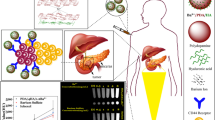Summary
Hyaluronic acid (HA), is a high molecular weight (HMW) glucosaminoglycan with significant acitivity, and which influences a number of physiological and pathological processes such as tumorogenesis, arthritis, etc. The aim of this study was to determine the difference in the biodistributional pathways of111in-labeled diethylenetriaminepentaacetic acid-hyaluronic acid (111In-DTPA-HA) molecule of three different MWs (10, 100 and 450 kDA) in a rat model, and to determine possible relationships between the biodistribution and the MW of the investigated agent for future medical applications.111In-DTPA-HA was prepared by mixing activated DTPA and activated HA, then adding111InCl3 to the previously prepared mixture at pH 5,5 in an acetic buffer. Biodistributional studies were performed using 36 male Wistar rats aged 2 months and weighing 280–350 g. The radioactivity in the samples was measured via a radiometer and the radioactivity in the different organs, blood, plasma and urine was determined. It was found that 50–54% for 10 and 100 kDa and 80% for 450 kDa of the administered dose of radiolabel was present in the liver after 5min. Other organs show no significant increase during the experimental period. The elimination of the radiolabel was mostly renal and in low molecular weight (LMW) form. Radioactivity remained in liver throughout the 72h experimental period. A difference in the biodistribution of 450 kDa and LMW radiolabeled molecules was found. Higher amounts of radiolabel were taken up by the liver when the 450 kDa molecule was used. LMW fractions were found in the urine, and could have been a product of non-enzymatic cleavage. The extended retention of radiolabel in the liver could be related to changes in the polarity of DTPA-HA molecules.
Similar content being viewed by others
References
Westerberg G., Bergstrom M., Gustafson S., Lindquist U., Sundin A., Langstrom B. (1995): Labelling of polysaccharides using [11C]Cynogen bromide. In vivo and in vitro evaluation of11C-hyaluronan uptake kinetics. Nucl. Med. Biol., 22, 251–256.
Klein C.E., Addadi L. (2003): Hyaluronan-mediated adhesion: visualizing pericellular hyaluronan and studying its role in cell matrix adhesion. In Hyaluronan 2003, Cleveland, OH, USA, p. 10.
McGary C.T., Raja R.H., Weigel P.H. (1989): Endocytosis of hyaluronic acid by rat liver endothelial cells. Biochem. J., 257, 875–884.
Fraser J.R.E., Appelgren L.E., Laurent T.C. (1983): Tissue uptake of circulating hyaluronic acid. Cell Tissue Res., 233, 285–293.
Smedsrod B., Pertoft H., Ericsson J. (1984): Studies in vitro on the uptake and degradation of sodium hyaluronate in rat liver endothelial cells. Biochem. J., 223, 617–626.
Fraser J.R.E., Kimpton W.G., Laurent T.C. (1988) Uptake of hyaluronan in lymphatic tissue. Biochem. J., 256, 153–158.
Fraser J.R.E., Laurent T.C., Pertoft H. (1981): Plasma clearance, tissue distribution and metabolism of hyaluronic acid injected intravenously in the rabbit. Biochem. J., 200, 415–424.
Laurent U.B.G., Dahl L.B., Reed R.K. (1991): Catabolism of hyaluronan in rabbit skin takes place locally in lymph nodes and liver. Exp. Physiol., 76, 695–703.
Komatsu S., Iwata H., Nabeshima T. (1999): Studies on the kinetics, metabolism and re-utilisation after intra-articular administration of hyaluronan to rabbits. Arzneim.-Forsch./Drug Res., 49, 427–433.
Thierry B., Winnik M.F., Merhi Y. (2004): Radionuclides-hyaluronan-conjugate thromboresistant coatings to prevent in-stent restenosis. Biomaterials, 25, 3895–3905.
Northup S.N., Ostasiw O.R., Brown H.D. (1973): Development of the hyaluronidase activity assay as a cancer screening test. Clin. Biochem., 6, 220–228.
Lepperdinger G., Mullegger J., Kreil G. (2001): Hyal2 — less active, but more versatile? Matrix Biol., 20, 509–514.
Muckenschnabel I., Bernhardt G., Spruss S., Dietl B., Buschauer A. (1998): Quantitation of hyaluronidases by the Morgan — Elson reaction: comparison of the enzyme activities in the plasma of tumor patients and healthy volunteers. Cancer Lett. 131, 13–20.
Tammi R., Saamanen A.M., Maibach I.A., Tammi M. (1991): Degradation of newly synthetised high molecular mass hyaluronan in the epidermal and dermal compartments of human skin in organ culture. Invest. Dermatol., 97, 126–130.
Day J.A., Prestwich G.D. (2002): Hyaluronan-binding proteins: tying up the giant. J. Biol. Chem., 277, 4585–4588.
Turley E.A., Noble P.W., Lilly Y.W. (2002): Signaling properties of hyaluronan receptors. J. Biol. Chem., 277, 4589–4592.
Nimrod A., Elchanan E., Ezov N. (1992): Absorption, distribution, metabolism and excretion of bacteria-derived hyaluronic acid in rats and rabbits. J. Ocular Pharmacol., 8, 161–172.
Fraser J.R.E., Laurent T.C., Laurent U.B.G. (1984): Elimination of hyaluronic acid from the bloodstream in the human. Clin.. Exp. Pharmacol. Physiol., 11, 17–25.
Author information
Authors and Affiliations
Rights and permissions
About this article
Cite this article
Svanovsky, E., Velebny, V., Laznickova, A. et al. The effect of molecular weight on the biodistribution of hyaluronic acid radiolabeled with111In after intravenous administration to rats. Eur. J. Drug Metabol. Pharmacokinet. 33, 149–157 (2008). https://doi.org/10.1007/BF03191112
Received:
Issue Date:
DOI: https://doi.org/10.1007/BF03191112




